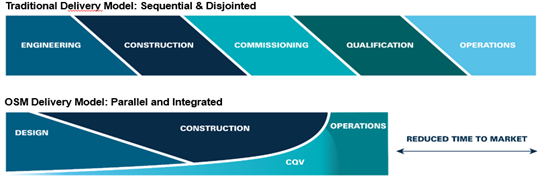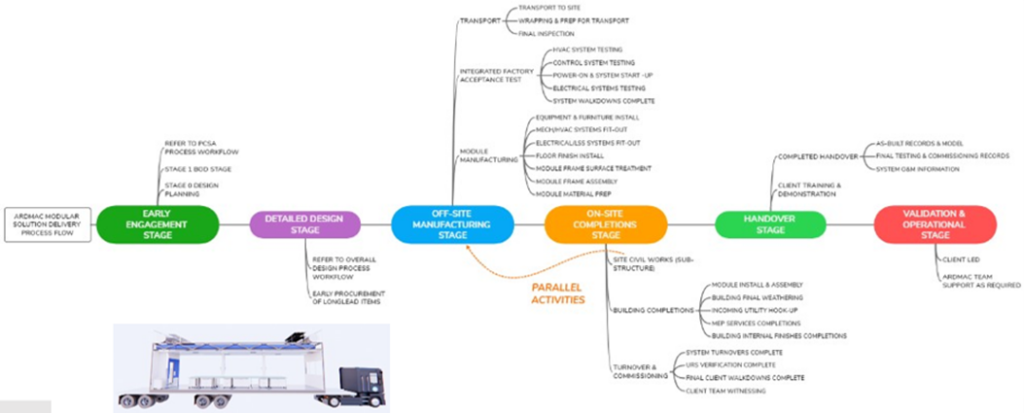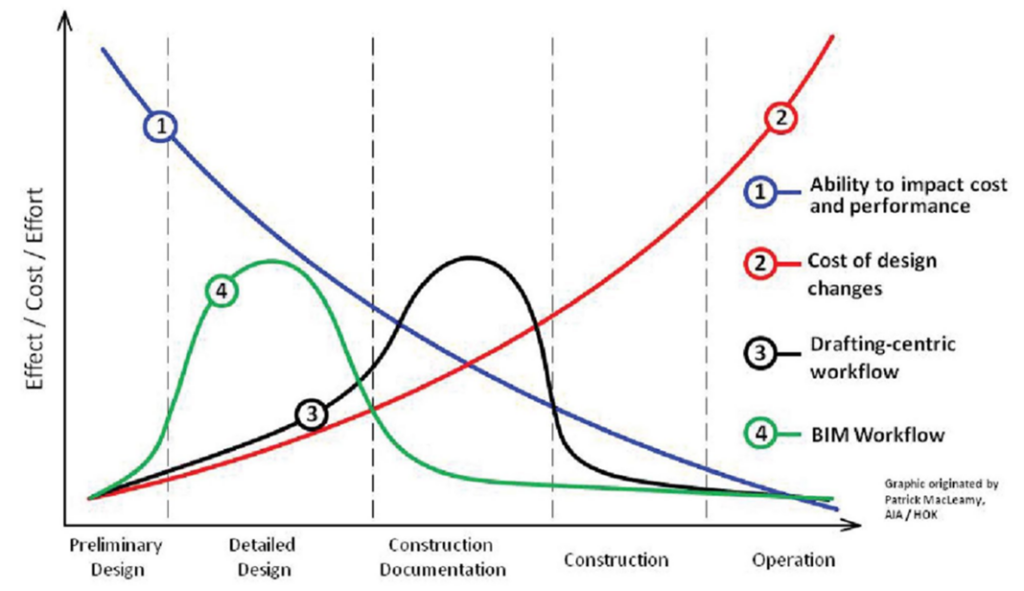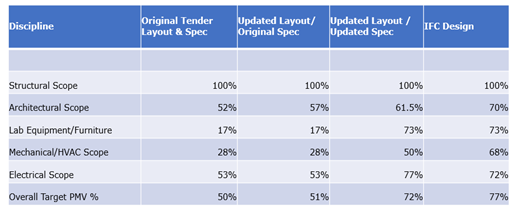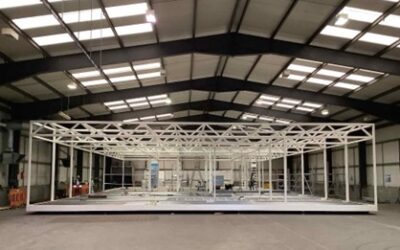Author : Enda Murphy
Lean Initiative Undertaken – Lean Thinking, Tools, Techniques
Over the last number of years, we have recognised a real need for change within the construction industry. There are several reasons for this shift in mindset:
- The impact of Covid-19.
The COVID-19 pandemic had a profound impact on the construction industry, triggering a series of challenges and changes. During the initial stages of the pandemic, construction sites around the world were shut down or faced significant disruptions, leading to project delays and financial strain on many companies. Safety protocols, social distancing measures, and supply chain disruptions further complicated operations, causing construction costs to rise.
To adapt, companies accelerated the adoption of digital technologies and remote work solutions. The pandemic has underscored the importance of flexibility, contingency planning, and innovation within the construction sector.
- Labour and material shortages globally.
In recent times, the construction industry has faced an acute challenge due to a widespread shortage of both labour and materials. The shortage of skilled labour has been a significant bottleneck, exacerbated by factors such as aging workforces and a decline in vocational training programs.
This scarcity of qualified workers has led to project delays and increased labour costs. Simultaneously, the global supply chain disruptions and increased demand for construction materials have caused unprecedented price hikes and delays in material deliveries. As a result, construction firms have had to adapt by finding innovative solutions, such as increasing automation and exploring alternative materials, to navigate these turbulent waters to meet their project deadlines and budgets.
- A growing demand from clients for MMC (Modern Methods of Construction) based solutions.
The construction industry is currently experiencing a remarkable surge in demand for modern methods of construction (MMC). This paradigm shift is driven by several factors, including the need for faster project completion, cost efficiency, and sustainability. MMC encompasses innovative techniques such as prefabrication, modular construction, and 3D printing, which significantly accelerate construction processes, reduce waste, and enhance precision in building structures. Moreover, as urbanization continues to rise, there is a growing emphasis on sustainable building practices, with MMC offering the advantage of reduced environmental impact through reduced resource consumption and enhanced energy efficiency.
As the industry continues to adapt to these evolving demands, it is clear that MMC is not just a trend but a fundamental transformation shaping the future of construction.
Within this setting, it is important to understand how we define MMC and PMV (pre-manufactures value) within this delivery model.
- MMC – Modern Methods of Construction: contemporary innovations in construction, including new technologies (digital tools, techniques, materials), offsite manufacture and use of efficient processes to deliver productive, sustainable, and better outcomes.
- PMV – Pre-Manufactured Value measures the amount of offsite construction involved in a project. Traditional construction typically has low PMV, whereas those incorporating MMC have high PMV.
- Misunderstood by some as a re-badge for offsite solutions, MMC extends far beyond volumetric, modular, or offsite manufacturing (OSM). It encapsulates broader themes of transformation that influence and impact where, how, why, and with whom we design and deliver built assets.
- MMC should be seen as a vehicle for more efficient project delivery rather than a specific technical solution.
In relation to this case study our requirement was to maximise our PMV. One of the main benefits of this approach was to reduce onsite labour hours, minimising our interfaces with adjacent trades in a congested environment, and having a positive effect on our safety and quality performance.
Figure 1: Traditional Delivery versus Off Site Manufacturing
The main enablers to MMC are Lean Design Processes and Digital Construction.
Lean thinking helps identify ways to reduce defects and errors, leading to higher product and service quality. Streamlined processes and reduced waste result in increased productivity, as employees can work more effectively and efficiently.
Lean techniques, like value stream mapping and pull systems, reduce lead times, allowing companies to respond more quickly to customer demands. Eliminating waste and improving efficiency can significantly reduce operating costs, which can boost profitability.
Lean thinking is customer centric. By delivering better quality and value, it leads to higher customer satisfaction and loyalty. Lean thinking involves employees in the continuous improvement process, leading to a more engaged and empowered workforce. This encourages flexibility and adaptability in response to changing market conditions and customer needs.
Lean Design Process
- Concise brief definition/ user requirement specification (URS).
- Accuracy and timely availability of design information is vital to project success.
- Stage Gate approach to design development.
- Strict Change Control essential.
- Standardised & repeatable design solutions.
- Component led design.
- Design phase pull-planning/ CPM.
- Focus on what design information adds value – value stream mapping.
- Improving process flow.
Figure 2: Execution Strategy: Overall project delivery process workflow
Digital Construction
Ardmac work “Smart”, meaning we deploy innovative technology throughout the business to empower our people, drive performance and delight our customers. We place the customer at the centre and apply lean construction principles and technology to everything we do. Our ultimate goal is to maximise value for our customers, and we believe that technology and innovation have the power to drastically change the face of the construction sector in the coming years.
Figure 3: Effect/ Cost/ Effort for project lifecycle
*A 2018 study found that reworks on-site account for up to 34% of total project costs.
Lean Initiative Improvements & Impact
Based on the use of our Lean Processes throughout the design phase we were able to progress the PMV value from an initial 50% value at tender stage to 77% at IFC stage through team collaboration and incorporation of modularised and standard components throughout the building.
Table 1: Target PMV Assessment Progression
As our leading guiding principle, Safety is our first consideration wherever we operate. Our projects are seeing less task change at site level which means increased control, risk reduction and improved safety audit scores.
By planning the works in an agreed sequence with predecessors and hand offs clearly understood as well as all constraints being removed in advance, we have seen a significant reduction in rework and therefore reduction of waste. As a result, we have been able to reduce our quality target to one punch list item per €25k at client walk down.
We have witnessed schedule functionality improve in two key ways. End dates that have been committed to are being achieved with little or no works to complete post practical completion. We are also seeing a shift in labour resource moving earlier into the programme and ramping down towards the end as opposed to ramping up reactively and having a more congested completion to the project.
We have found that the effort required to close out a project in the final weeks has become a lot more controlled and less stressful, leaving more time to access standard of finish, safety control and ultimately deliver projects to our clients with maximum value.
With improvements in safety, quality, schedule and labour, we have seen improvements commercially, allowing us to cost risk in a different manner and also making our supply chain more competitive, as they have worked with us on projects utilising LPS bringing less risk to their own output.
Summary & Lessons Learned
Summary
We are currently in a time of challenge and within the BioPharma sector, one of the areas where our modular approach has been applied, there are a number of pressures and critical factors involved in facility design:
- Increased Diversification
Companies moving away from single-product specialisation with multiple product types in development simultaneously. - Need for Greater Flexibility
Adaptive facilities that can expand and contract with rapid R&D development or changes in business strategy. - Need for Reduced Timelines
Speed of delivery including regulatory approval allows for clinical stage companies to rapidly progress towards commercialization. - Need for Innovative Facility Design
A need for multi-modal and agile facilities that can meet the technical challenges facing gene and cell therapies. - Need for Improved ROI
Companies taking a more cautious approach to NPD (new product development) & expansion with investment in facilities being pushed further along the product life cycle. - Alignment with Sustainability Goals
Global companies keenly aware of the need to ensure development plans align with Sustainability Goals.
Lessons Learned
To achieve our goal, there are several key success factors:
- Standardised components – design ready.
- Collective Project Team Buy-in from inception to operation.
- Design Completion – fully approved design prior to commencing manufacturing.
- Robust Change Control Process – potential impact of change on a project is magnified in the context of OSM.
- Project Suitability – optimized solution.
- Delivering on MMC benefits – Building confidence in the approach.
- Innovative mindset – open to change.
Our objective was to support and increase LEAN engagement understanding based on our experience. We recognise that our experiences in recent years have been instrumental in us achieving a higher level of engagement across our organisation.
We continue to be a driver for LEAN within the construction industry and will continue to communicate the efficiencies and successes LEAN bring to our business, clients and peers. LEAN construction principles deserve recognition as an innovative way of improving productivity on site and our teams are proud to be ambassadors for innovation and change.

